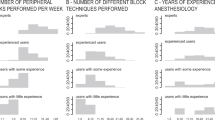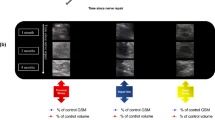Abstract
Background and objectives:
In particular, obese patients may profit from peripheral regional anaesthesia due to avoidance of general anaesthesia. Currently, ultrasound (US) guidance is described as the golden standard in regional anaesthesia, but no studies have so far evaluated the US behaviour of peripheral nerve structures in obese versus normal-weight patients. To be able to perform such studies, it is necessary to develop new and more objective methods to quantify nerve visibility by US. We therefore designed a prospective, observational, comparative and blinded study to investigate the visibility of peripheral nerves in obese versus normal-weight patients by using a novel method based on histogram grey-scale values.
Methods:
We scanned the median and sciatic nerves in 40 obese and normal-weight female patients and calculated differences of histogram grey-scale values between nerves and surrounding tissues.
Results:
Histogram value analysis showed less US visibility of sciatic nerves in obese versus normal-weight study patients, which is caused by higher surrounding tissue histogram values. No differences could be detected for median nerves.
Conclusions:
The novel technique of comparing histogram grey-scale values to determine the visibility of the peripheral nerve in different patient categories was found feasible. Median nerves are appropriately visible by US in both normal and obese subjects, whereas sciatic nerves are less visible in obese as compared with normal-weight women. Our results serve as the rationale behind difficulties in peripheral regional anaesthesia in obese patients.
This is a preview of subscription content, access via your institution
Access options
Subscribe to this journal
Receive 12 print issues and online access
$259.00 per year
only $21.58 per issue
Buy this article
- Purchase on Springer Link
- Instant access to full article PDF
Prices may be subject to local taxes which are calculated during checkout



Similar content being viewed by others
References
WHO. Obesity and overweight 2011, http://www.who.int/mediacentre/factsheets/fs311/en/.
Boutonnet M, Faitot V, Keita H . [Airway management in obstetrics]. Ann Fr Anesth Reanim 2011; 30: 651–664.
Kristensen MS . Airway management and morbid obesity. Eur J Anaesthesiol 2010; 27: 923–927.
Hans GA, Lauwick S, Kaba A, Brichant JF, Joris JL . Postoperative respiratory problems in morbidly obese patients. Acta Anaesthesiol Belg 2009; 60: 169–175.
Franco CD, Gloss FJ, Voronov G, Tyler SG, Stojiljkovic LS . Supraclavicular block in the obese population: an analysis of 2020 blocks. Anesth Analg 2006; 102: 1252–1254.
Ingrande J, Brodsky JB, Lemmens HJ . Regional anesthesia and obesity. Curr Opin Anaesthesiol 2009; 22: 683–686.
Schwemmer U, Papenfuss T, Greim C, Brederlau J, Roewer N . Ultrasound-guided interscalene brachial plexus anaesthesia: differences in success between patients of normal and excessive weight. Ultraschall Med 2006; 27: 245–250.
Marhofer P, Willschke H, Kettner S . Current concepts and future trends in ultrasound-guided regional anesthesia. Curr Opin Anaesthesiol 2010; 23: 632–636.
Marhofer P, Harrop-Griffiths W, Willschke H, Kirchmair L . Fifteen years of ultrasound guidance in regional anaesthesia: Part 2-recent developments in block techniques. Br J Anaesth 2010; 104: 673–683.
Marhofer P, Harrop-Griffiths W, Kettner SC, Kirchmair L . Fifteen years of ultrasound guidance in regional anaesthesia: part 1. Br J Anaesth 2010; 104: 538–546.
Griffin J, Nicholls B . Ultrasound in regional anaesthesia. Anaesthesia 2010; 65: 1–12.
Hopkins PM . Ultrasound guidance as the gold standard in regional anaesthesia. Br J Anaesth 2007; 98: 299–301.
Li X, Karmakar KM, Lee A, Kwok WH, Critchley LA, Gin T . Quantitative evaluation of the echo intensity of the median nerve and flexor muscles of the forearm in the young and the elderly. Br J Radiol 2012; 85: 140–145.
Gattinoni L, Pesenti A, Bombino M, Baglioni S, Rivolta M, Rossi F, Rossi G, Fumagalli R, Marcolin R, Mascheroni D et al. Relationships between lung computed tomographic density, gas exchange, and PEEP in acute respiratory failure. Anesthesiology 1988; 69: 824–832.
Kapral S, Krafft P, Eibenberger K, Fitzgerald R, Gosch M, Weinstabl C . Ultrasound-guided supraclavicular approach for regional anesthesia of the brachial plexus. Anesth Analg 1994; 78: 507–513.
Thallaj A, Marhofer P, Kettner SC, Al-Majed M, Al-Ahaideb A, Moriggl B . High-resolution ultrasound accurately identifies the medial antebrachial cutaneous nerve at the midarm level: a clinical anatomic study. Reg Anesth Pain Med 2011; 36: 499–501.
Thallaj A, Marhofer P, Moriggl B, Delvi BM, Kettner SC, Almajed M . Great auricular nerve blockade using high resolution ultrasound: a volunteer study. Anaesthesia 2010; 65: 836–840.
Chantzi C, Saranteas T, Zogogiannis J, Alevizou N, Dimitriou V . Ultrasound examination of the sciatic nerve at the anterior thigh in obese patients. Acta Anaesthesiol Scand 2007; 51: 132.
Hayashi H, Ueyama H . [Experience of ultrasound-guided popliteal sciatic nerve block and femoral nerve perineural catheter placement in a morbidly obese patient undergoing total knee arthroplasty]. Masui 2010; 59: 1260–1262.
Saranteas T . Limitations in ultrasound imaging techniques in anesthesia: obesity and muscle atrophy? Anesth Analg 2009; 109: 993–994.
Lee CH, Choi JW, Kim KA, Seo TS, Lee JM, Park CM . Usefulness of standard deviation on the histogram of ultrasound as a quantitative value for hepatic parenchymal echo texture; preliminary study. Ultrasound Med Biol 2006; 32: 1817–1826.
Maeda K, Utsu M, Yamamoto N, Serizawa M . Echogenicity of fetal lung and liver quantified by the grey-level histogram width. Ultrasound Med Biol 1999; 25: 201–208.
Osawa H, Mori Y . Sonographic diagnosis of fatty liver using a histogram technique that compares liver and renal cortical echo amplitudes. J Clin Ultrasound 1996; 24: 25–29.
Acknowledgements
Funding: Only intramural departmental resources were used.
Author information
Authors and Affiliations
Corresponding author
Ethics declarations
Competing interests
Profs Peter Marhofer and Lonnqvist received honoraria from SonoSite Inc. Dr Pilz-Lubsczyk and Prof Fleischmann declare no conflict of interest.
Additional information
Parts of the manuscript have been presented at the ESRA Annual Meeting 2011.
Rights and permissions
About this article
Cite this article
Marhofer, P., Pilz-Lubsczyk, B., Lönnqvist, PA. et al. Ultrasound-guided peripheral regional anaesthesia: a feasibility study in obese versus normal-weight women. Int J Obes 38, 451–455 (2014). https://doi.org/10.1038/ijo.2013.119
Received:
Revised:
Accepted:
Published:
Issue Date:
DOI: https://doi.org/10.1038/ijo.2013.119



